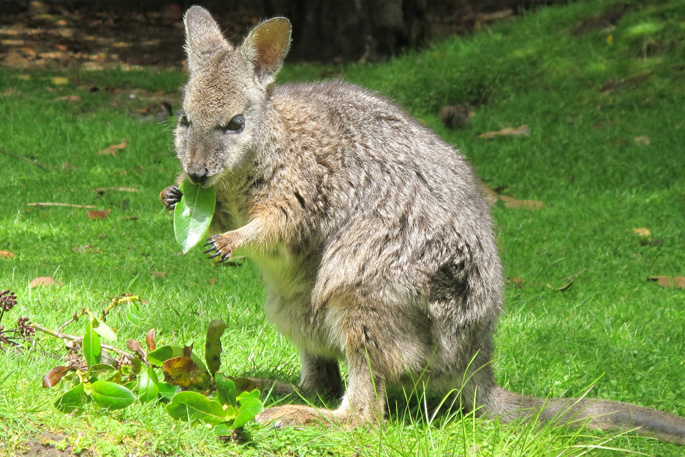It was the unmistakable silhouette of a wallaby that excited. A Facebook post of an about-to-be deceased wallaby as it leapt across the railway lines in front of several hundred tonnes of logging train between Murupara and Kawerau. “It was there going into the yard,” said the trainer driver. “And it was there coming out.” He snapped the wallaby on his phone as evidence.
“That’s the problem – it’s not deceased,” says rueful Bay of Plenty Regional Council biosecurity officer Dale Williams. The wallaby was too quick for the train. So Dale dispatched a contractor with indicating dogs to flush out the Ozzie invader. But it had disappeared into a blackberry thicket.
That made Dale slightly uneasy. “That wallaby is a long way from the main breeding population around Kaingaroa Forest. It’s also only 1km or so from the Rangitikei River bridge. And that’s of real concern.”
If the wallaby crosses the Rangitikei, the next stop is Te Urewera – a vast, heavily-forested, sparsely-populated and protected area and home to Ngai Tuhoe. “We certainly don’t want them in there. We definitely don’t want wallabies established there. It would have a major negative impact and be very difficult to manage.”
Why all the angst? The dama wallaby, macropus eugenii, looks so cute – just 530mm high, weighing up to 7kg, sleek grey-brown coat with pale belly, greenish-yellow eyes and the irresistible ‘take-me-home and cuddle me’ appeal.
“That’s half the problem,” admits Dame. “Look at stoats and the impact is obvious, they kill kiwis. People see an immediate problem. But then they go: ‘Oh, I didn’t know we had wallaby’. Or: ‘I can’t see the problem, they just chew grasses and shrubs and things’.”
But that can have a huge impact on our birdlife for instance. The exotic trees they eat the seedlings of may also produce a lot of seed the birds eat. “So over time there’s a slow and insidious change to the forest,” says Dale. “The wallaby works slowly and systematically nipping off every palatable seedling. “And that completely removes the regeneration of some species. The impact is quite dramatic.”
The wallaby, classified as an unwanted organism under our biosecurity legislation, inhabits 200,000ha east of Rotorua. The spread is not alarming – but it’s a bit of the hare and tortoise thing. It’s slow but sure. And the Western Bay of Plenty is not immune – wallabies are knocking at our door, nibbling at our seedlings. They’ve reached Paengaroa.
“Go to the end of Allport Rd, east of Paengaroa, and there’s a small DOC reserve called Roydon Downs. “They’re established there,” says Dale. “They’ll be in the pine forest to the west, and across the state highway in Sun Valley right up to the Kaituna River.” And there’s a natural barrier like the open pastureland in the area.
The new pest management plan is one of progressive containment, preventing the spread of wallabies. Dale has some tools in his box like pesticides – cyanide and 1080. There’s night shooting with thermal imaging, scopes and night vision. “They live in scrub during the day and at night if they have access to good quality pasture, they’ll come out and feed. So night shooting is good. Problem solved.”
But they need people on-board – who will advise regional council if they spot a wallaby. They’re wanted dead or alive. There is a reporting app for cellphones where people can put in: www.stoppests.co.nz This will open a questionnaire, asking for contact details and where a wallaby was sited. There’s also a digital map where you can drag the marker to where you saw the wallaby. Dale will be very glad to hear from you.



0 Comments
Leave a Comment